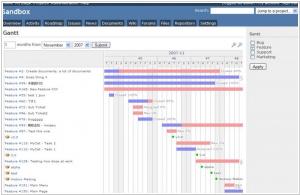JIRA vs Redmine
March 10, 2025 | Author: Michael Stromann
82★
JIRA provides issue tracking and project tracking for software development teams to improve code quality and the speed of development. Combining a clean, fast interface for capturing and organising issues with customisable workflows, OpenSocial dashboards and a pluggable integration framework, JIRA is the perfect fit at the centre of your development team.
14★
Redmine is a flexible alternative project management web application. Written using the Ruby on Rails framework, it is cross-platform and cross-database. Redmine is open source and released under the terms of the GNU General Public License v2 (GPL).
See also:
Top 10 Issue-tracking systems
Top 10 Issue-tracking systems
Project management tools are a lot like intergalactic hitchhiking: you need a reliable way to track where you've been, where you're going and which terrifying space bureaucracy is currently making your life miserable. JIRA and Redmine both promise to do exactly that. They let you manage tasks, chase deadlines and generally feel like you’re in control of things—at least until your boss asks for a report you forgot to generate. They support agile workflows, have customizable issue tracking and let teams pretend everything is running smoothly while quietly panicking in the background.
JIRA, hailing from the distant lands of Australia (where even the project management tools might try to kill you), has been around since 2002 and is largely designed for software development teams who like their dashboards filled with more data than anyone could possibly understand. It’s slick, it’s powerful and it integrates with just about every tool you can think of—whether you need it to or not. It’s also got fancy built-in analytics, a cloud version that ensures you’re never quite sure where your data is and a pricing model that can make a CFO faint on sight.
Redmine, on the other hand, emerged in 2006 as an open-source alternative for people who prefer things simple, self-hosted and not actively trying to upsell them every five minutes. It’s built on Ruby on Rails, which means it appeals to a certain breed of tech enthusiast who enjoys wrestling with configuration files late at night. It lacks JIRA’s glitzy UI, but it makes up for it with flexibility, a community-driven approach and the smug satisfaction of not being locked into a corporate ecosystem. It’s the kind of tool that might not always hold your hand, but at least it won’t slap it away and demand a subscription fee.
See also: Top 10 Issue Trackers
JIRA, hailing from the distant lands of Australia (where even the project management tools might try to kill you), has been around since 2002 and is largely designed for software development teams who like their dashboards filled with more data than anyone could possibly understand. It’s slick, it’s powerful and it integrates with just about every tool you can think of—whether you need it to or not. It’s also got fancy built-in analytics, a cloud version that ensures you’re never quite sure where your data is and a pricing model that can make a CFO faint on sight.
Redmine, on the other hand, emerged in 2006 as an open-source alternative for people who prefer things simple, self-hosted and not actively trying to upsell them every five minutes. It’s built on Ruby on Rails, which means it appeals to a certain breed of tech enthusiast who enjoys wrestling with configuration files late at night. It lacks JIRA’s glitzy UI, but it makes up for it with flexibility, a community-driven approach and the smug satisfaction of not being locked into a corporate ecosystem. It’s the kind of tool that might not always hold your hand, but at least it won’t slap it away and demand a subscription fee.
See also: Top 10 Issue Trackers





